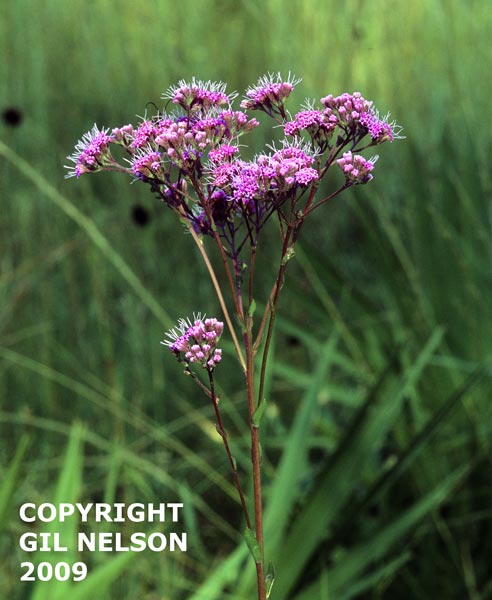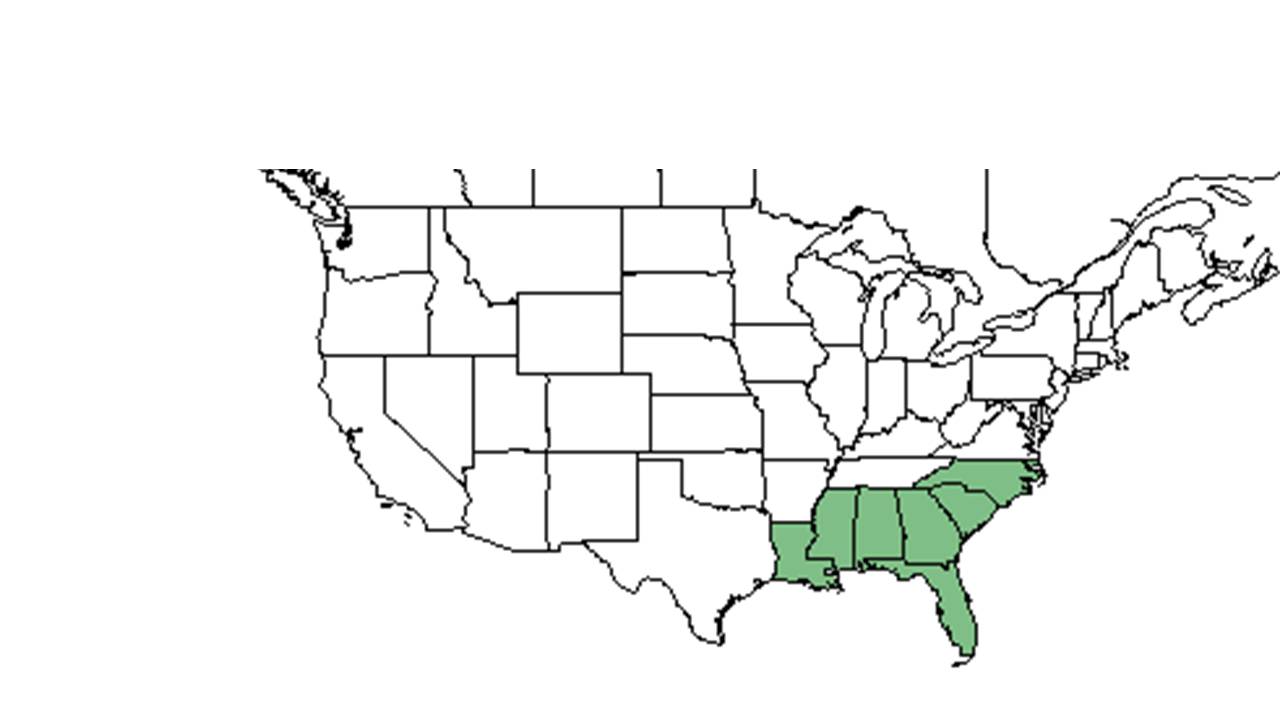Difference between revisions of "Trilisa odoratissima"
HaleighJoM (talk | contribs) (→Ecology) |
|||
| Line 17: | Line 17: | ||
| range_map_caption = Natural range of ''Trilisa odoratissima'' from USDA NRCS [http://www.plants.usda.gov/core/profile?symbol=CAOD3 Plants Database]. | | range_map_caption = Natural range of ''Trilisa odoratissima'' from USDA NRCS [http://www.plants.usda.gov/core/profile?symbol=CAOD3 Plants Database]. | ||
}} | }} | ||
| − | Common names: | + | Common names: Vanilla-leaf, Deer's-tongue |
==Taxonomic notes== | ==Taxonomic notes== | ||
| − | Synonyms: ''Carphephorus odoratissimus''.<ref>Weakley, A.S. | + | Synonyms: ''Carphephorus odoratissimus''; ''C. odoratissimus'' (J.F. Gmelin) Herbert var. ''odoratissimus''; ''T. odoratissima'' var. ''odoratissima''<ref name=weakley>Weakley, A.S. 2020. Flora of the Southeastern United States. Edition of 20 October 2020. University of North Carolina at Chapel Hill, Chapel Hill, North Carolina.</ref> |
| + | |||
| + | Varieties: none<ref name=weakley/> | ||
==Description== | ==Description== | ||
Latest revision as of 13:26, 22 May 2023
| Trilisa odoratissima | |
|---|---|

| |
| Photo taken by Gil Nelson | |
| Scientific classification | |
| Kingdom: | Plantae |
| Division: | Magnoliophyta - Flowering plants |
| Class: | Magnoliopsida – Dicotyledons |
| Order: | Asterales |
| Family: | Asteraceae ⁄ Compositae |
| Genus: | Trilisa |
| Species: | T. odoratissima |
| Binomial name | |
| Trilisa odoratissima (J.F. Gmel.) Herb. | |

| |
| Natural range of Trilisa odoratissima from USDA NRCS Plants Database. | |
Common names: Vanilla-leaf, Deer's-tongue
Contents
Taxonomic notes
Synonyms: Carphephorus odoratissimus; C. odoratissimus (J.F. Gmelin) Herbert var. odoratissimus; T. odoratissima var. odoratissima[1]
Varieties: none[1]
Description
A description of Trilisa odoratissima is provided in The Flora of North America.
Distribution
Ecology
Habitat
It is found in frequently burned pine flatwoods or dry prairies[2] and moist areas, depressions, and seepages within burned upland longleaf pine-wiregrass communities[3] and oak-pine woodlands on Ultisols, as well as sand ridges within flatwoods and pine-saw palmettos.[4] It was absent from the seed bank in disturbed and undisturbed sites in North Carolina.[5] It occurs primarily on sandy and drying loamy soils.[4] It is found in disturbed areas such as roadsides, fields, and ditches as well as undisturbed sites.[5][4] T. odoratissima does not respond to soil disturbance by clearcutting and chopping in north Florida flatwoods forests.[6] T. odoratissima is restricted to native groundcover with a statistical affinity in upland pinelands of South Georgia.[7] While this species is found in the uplands, it is found in the lowlands as well (FSU Herbarium).
Associated species include Quercus, Pinus, Pinus elliottii, Sabal palmetto, and Aristida stricta.[4]
Phenology
It has been seen flowering September through November and fruiting in October through November.[4]
Fire ecology
Trilisa odoratissima is fire-tolerant,[5] as shown by populations that have been known to persist through repeated annual burns.[8][9] T. odoratissima was a prevalent species on burned plots.[10]
Pollination
The following Hymenoptera families and species were observed visiting flowers of T odoratissima at Archbold Biological Station:[11]
Apidae: Bombus pennsylvanicus
Halictidae: Augochlorella aurata, Halictus poeyi
Megachilidae: Coelioxys octodentata, C. sayi, Dianthidium floridiense, Megachile albitarsis, M. inimica
Conservation, cultivation, and restoration
Cultural use
The leaves have been used as a vanilla-like flavoring in pipe tobacco and cigars. Additionally, a tonic can be made from the leaves for treating malaria.[12]
Photo Gallery
References and notes
- ↑ 1.0 1.1 Weakley, A.S. 2020. Flora of the Southeastern United States. Edition of 20 October 2020. University of North Carolina at Chapel Hill, Chapel Hill, North Carolina.
- ↑ Carrington, M. E. and J. J. Mullahey (2013). "Saw palmetto (Serenoa repens) flowering and fruiting response to time since fire." Rangeland Ecology & Management 66: 43-50.
- ↑ Kirkman, L. K., M. B. Drew, et al. (1998). "Effects of experimental fire regimes on the population dynamics of Schwalbea americana L." Plant Ecology 137: 115-137.
- ↑ 4.0 4.1 4.2 4.3 4.4 Florida State University Robert K. Godfrey Herbarium database. URL: http://herbarium.bio.fsu.edu. Last accessed: June 2014. Collectors: L. C. Anderson, E. L. Bridges, E. H. Butts, A. F. Clewell, R. K. Godfrey, R. D. Houk, R. Komarek, R. Kral, R. L. Lazor, J. Morrill, R. A. Norris, S. L. Orzell, J. D. Ray Jr., P. L. Redfearn Jr., V. I. Sullivan and R. White. States and Counties: Florida: Bay, Duval, Escambia, Franklin, Gadsden, Gulf, Holmes, Jefferson, Lafayette, Leon, Liberty, Madison, Nassau, Okaloosa, Pasco, Polk, Putnam, Santa Rosa, Taylor, Wakulla, and Walton. Georgia: Grady and Thomas.
- ↑ 5.0 5.1 5.2 Cohen, S., R. Braham, et al. (2004). "Seed bank viability in disturbed longleaf pine sites." Restoration Ecology 12: 503-515.
- ↑ Moore, W.H., B.F. Swindel, and W.S. Terry. (1982). Vegetative Response to Clearcutting and Chopping in a North Florida Flatwoods Forest. Journal of Range Management 35(2):214-218.
- ↑ Ostertag, T.E., and K.M. Robertson. 2007. A comparison of native versus old-field vegetation in upland pinelands managed with frequent fire, South Georgia, USA. Pages 109–120 in R.E. Masters and K.E.M. Galley (eds.). Proceedings of the 23rd Tall Timbers Fire Ecology Conference: Fire in Grassland and Shrubland Ecosystems.
- ↑ Robertson, K.M. Unpublished data collected from Pebble Hill Fire Plots, Pebble Hill Plantation, Thomasville, Georgia.
- ↑ Platt, W.J., R. Carter, G. Nelson, W. Baker, S. Hermann, J. Kane, L. Anderson, M. Smith, K. Robertson. 2021. Unpublished species list of Wade Tract old-growth longleaf pine savanna, Thomasville, Georgia.
- ↑ Kush, J. S., R. S. Meldahl, et al. (1999). "Understory plant community response after 23 years of hardwood control treatments in natural longleaf pine (Pinus palustris) forests." Canadian Journal of Forest Research 29: 1047-1054.
- ↑ Deyrup, M.A. 2015. Database of observations of Hymenoptera visitations to flowers of plants on Archbold Biological Station, Florida, USA.
- ↑ Korchmal, Arnold & Connie. 1973. A Guide to the Medicinal Plants of the United States. The New York Times Book Company, New York.